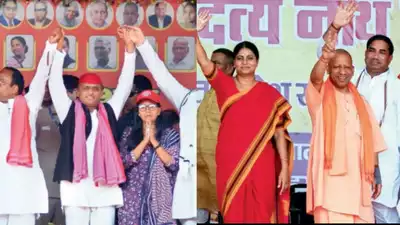
The arid lands of Mirzapur eagerly await the arrival of rains to alleviate the scorching heat. This thirst for water extends to the political arena, where water scarcity could play a pivotal role. Situated along the banks of the Ganga River, the district grapples with a shortage of potable and non-potable water, emerging as a significant election issue. Mirzapur has gained recognition, partly due to the popularity of the OTT series ‘Mirzapur’.
The primary irrigation source for over three dozen villages in the Marihaan sub-division of Mirzapur is a canal. However, the sluice gates providing water to this canal were last opened during the 2022 Rabi season. Today, the canal’s origin has dried up, and its bed is covered in algae. Local resident Baba Yadav, also a worker of the Apna Dal (Sonelal) faction, expresses the villagers’ plight, highlighting the challenges they face due to the lack of water for agriculture. The irregular power supply further exacerbates their struggles.
Mirzapur stands out as one of the driest regions in the state, where farmers heavily rely on monsoon-fed dams and reservoirs for agriculture. However, drilling borewells is challenging due to the presence of red sandstone and rocky terrains. Amidst this backdrop, water scarcity emerges as a pressing concern for the district’s residents.
In the political arena, Mirzapur presents a unique electoral landscape. The constituency has a history of not re-electing an MP for more than two consecutive terms. Anupriya Patel, representing Apna Dal (Sonelal), seeks to defy this trend but faces stiff competition. She contends against Ramesh Chand Bind, a BJP turncoat and the incumbent MP from neighboring Bhadohi, who now runs on the SP ticket.
Mirzapur comprises diverse assembly segments, each with its unique socio-political dynamics. While the region is popularly associated with fictional gun-toting mafia figures, the real-life concerns revolve around issues like the carpet industry, caste dynamics, and urban development projects. The local carpet industry, while renowned, faces challenges such as rolled-back incentives and increased regulatory burdens.
Caste dynamics also come into play in Mirzapur’s electoral landscape. Scheduled Caste voters, comprising a significant portion of the population, hold the potential to sway election outcomes. The OBC community, particularly Patels, forms a crucial voting bloc, with Anupriya enjoying considerable support from them.
Urban voters in Mirzapur cite improved infrastructure and development projects as factors that could influence their voting decisions. Projects like the upcoming Vindhyavasini shrine corridor and proposed investment initiatives may tilt favour towards the BJP-Apna Dal (S) alliance.
The electoral battle in Mirzapur also witnesses interesting subplots, including the clash between Raja Bhaiya and Anupriya Patel. However, the ground reality suggests that such narratives do not always resonate strongly among voters compared to social media discourse.
Overall, Mirzapur’s electoral landscape is a complex tapestry woven with issues of water scarcity, caste dynamics, and development aspirations, shaping the contours of political contestation in the region.